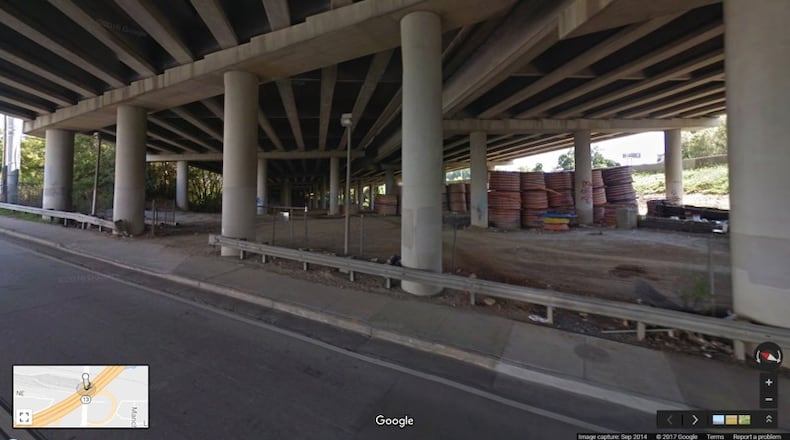The huge spools of plastic and fiberglass conduit that caught fire and caused the I-85 bridge to collapse in Buckhead last week came to be stored under the elevated highway because of an unfinished project a decade earlier, officials told The Atlanta Journal-Constitution Tuesday.
Officials also said that similar material is not stored under any other state highway bridges and they defended their decision to keep the conduit material under the I-85 bridge for years.
Meanwhile, the Georgia Department of Transportation has agreed to cooperate with the federal agency that investigates transportation accidents and incidents.
National Transportation Safety Board spokesman Eric Weiss said the agency will examine the safety of storing materials under highways.
“Our concern is basically the storage of flammable construction materials under infrastructure,” Weiss said. Results of the NTSB investigation will be turned over to the Federal Highway Administration and state officials, Weiss said.
The first detailed explanation as to why state transportation officials stored tons of the conduit in a fenced-off area under the bridge emerged Tuesday, when GDOT Commissioner Russell McMurry said during a press conference that it was intended for a 2007 traffic management project on Georgia 400.
McMurry has called the conduit “non-combustible,” meaning that it would harder to ignite than material that was labeled flammable. He said Smyrna-based contractor, TDC Systems Integration, defaulted on the traffic management project a few months after being awarded the contract, and after the state paid for the material to be used for it.
The next contractor used a different type of conduit for the project, according to McMurry.
Tony Dozier, president of TDC Systems, disputed the state’s claim that the project unravelled due to default.
Material intended for another project
Whatever the reason for the delay, McMurry said his agency was being fiscally responsible by storing the material under the highway.
“In an effort to save taxpayer dollars, GDOT chose to store the material in hopes that it could be used for another project,” McMurry said. “The material was stored on state property, behind a fence with a locked gate. And there was a sign placed that it was state property and no trespassing.
“The area was breached by individuals … with the devastating outcome we are now dealing with.”
Three homeless people were arrested Friday night, but only Basil Eleby was charged with arson. Police say Eleby set a chair on fire and left the scene.
Tony Radoszewski, president of the non-profit trade organization Plastics Pipe Institute, said high density polyethylene is a safe product used in many ways — from orange barrels for road construction to water bottles and gas tanks. But Radoszewski said he’s never seen it stored under a highway overpass.
“Typically, the materials used in construction are stored in open areas like distribution yards, maintenance yards, storage yards,” Radoszewski said. “I’m not aware of any instance where that material has been stored under bridge overpasses. I was surprised by that.
“High-density polyethylene pipe by itself is not going to burst into flames. But if somebody is going to set it on fire, it will burn.”
William Perry, founder of the Georgia Ethics Watchdogs, said he doesn’t buy McMurry’s claim that GDOT was trying to save tax dollars.
“That sounds like spin to me,” Perry said. “There was no careful inventory, no controls in place to reuse the material. I’m sure it had value, so sell it on eBay.”
McMurry said he’s not sure how much of the conduit was stored under the bridge. A GDOT spokeswoman declined to release the TDC Systems’ contract to the AJC Tuesday, saying that state lawyers wouldn’t allow it until the NTSB approved.
When asked why the state didn’t require the second contractor to use the conduit taxpayers had already purchased, GDOT spokeswoman Natalie Dale said: “The next project was five years later. Conduit specs were changed … to ensure the department’s needs were most efficiently met.”
State: stored spools did not violate policy
McMurry said the conduit was initially stored at the intersection of Sidney Marcus Boulevard and Buford Highway. It was moved under the I-85 bridge near Piedmont Road in 2012, as GDOT began construction of another project on Georgia 400.
The photos show the spools secured by a chain-link fence with a double gate that was sometimes left open. Even when locked, it would have been possible for a person to slip in between the gates or climb over the fence.
McMurry said storing the material under the interstate bridge did not violate any GDOT policy, and the fencing and gates were intended more to keep the material in than to keep people out.
“The gating and fencing was really to keep the material from being stolen,” McMurry said. “Obviously, from what we know now, we would not have stored the material in the fashion it was stored in.”
Dozier, with TDC Systems, said his company typically has conduit material delivered directly to a job site. But when he does store the material on his company’s property, it’s typically in a warehouse or in an enclosed staging area.
“GDOT paid for it, why did they store it under that bridge?” Dozier asked. “If we have to store that material, it’s in a warehouse or in a yard that’s fenced with electronic surveillance.”
About the Author
The Latest
Featured



